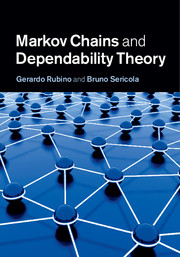Book contents
- Frontmatter
- Contents
- 1 Introduction
- 2 Discrete-time Markov chains
- 3 Continuous-time Markov chains
- 4 State aggregation
- 5 Sojourn times in subsets of states
- 6 Occupation times of subsets of states – interval availability
- 7 Linear combination of occupation times – performability
- 8 Stationarity detection
- 9 Simulation techniques
- 10 Bounding techniques
- References
- Index
9 - Simulation techniques
Published online by Cambridge University Press: 05 July 2014
- Frontmatter
- Contents
- 1 Introduction
- 2 Discrete-time Markov chains
- 3 Continuous-time Markov chains
- 4 State aggregation
- 5 Sojourn times in subsets of states
- 6 Occupation times of subsets of states – interval availability
- 7 Linear combination of occupation times – performability
- 8 Stationarity detection
- 9 Simulation techniques
- 10 Bounding techniques
- References
- Index
Summary
Simulating a Markov model is the method of choice when analytic or numerical approaches are not possible. Basically, the former happens when the model is not regular enough, meaning that it does not have enough structure, the latter when its size precludes the use of numerical procedures. We also use the term Monte Carlo to refer to these simulation methods, using the term in its most common meaning, i.e. the use of randomness to solve deterministic problems. There are many important subfields in this wide area that have been the object of concerted research efforts, for instance the MCMC [83], [31] or the perfect simulation [81] approaches, and many procedures designed for specific application areas, such as queuing [52], [38], [109], financial problems [37], physics [40], and many more [45], [35], [4]. Monte Carlo techniques are extremely powerful, and they can deal, in principle, with any kind of model. They are not limited by the lack of structure in the model, nor by the model's size. However, they have their own difficulties, the main one being the case of rare events. If you want to analyze a specific metric quantifying some aspect of this rarity, the fact that the focused event appears with very small probability means that it will also be hard to observe in the simulation.
- Type
- Chapter
- Information
- Markov Chains and Dependability Theory , pp. 201 - 229Publisher: Cambridge University PressPrint publication year: 2014



